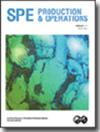Investigation of Microseismicity and Permeability Evolution in Shale Fractures during Stimulation
IF 1.3
4区 工程技术
Q2 ENGINEERING, PETROLEUM
引用次数: 2
Abstract
Shear slip of pre-existing fractures can play a crucial role in hydraulic stimulation to enable production from unconventional shale reservoirs. Evidence of the phenomenon is found in microseismic/seismic events induced during stimulation by hydraulic fracturing. However, induced seismicity and permeability evolution in response to fracture shear slip by injection have not been extensively studied in laboratory tests under relevant conditions. In this work, a cylindrical Eagle Ford Shale sample having a single fracture (tensile fracture) was used to perform a laboratory injection test with concurrent acoustic emission (AE) monitoring. In the test, shear slip was induced on the fracture at near critical stress state by injecting pressurized brine water [7% potassium chloride (KCl)]. Sample deformation (stress, displacement), fluid flow (injection pressure, flow rate), and AE signals (hits, events) were all recorded. The data were then used to characterize the fully coupled seismo-hydromechanical response of the shale fracture during shearing. Results show that the induced AE/microseismic events correlate well with the fracture slip and the permeability evolution. Most of the recorded AE hits and events were detected during the seismic-slip interval corresponding to a rapid fracture slip and a large stress drop. As a result of dilatant shear slip, a remarkable enhancement of fracture permeability was achieved. Before this seismic interval, an aseismic-slip interval was evident during the tests, where the fracture slip, associated stress relaxation, and permeability increase were limited. The test results and analyses demonstrate the role of shear slip in permeability enhancement and induced seismicity by hydraulic stimulation for unconventional shale reservoirs.页岩裂缝在增产过程中的微地震性和渗透率演化研究
已有裂缝的剪切滑动在水力增产中发挥着至关重要的作用,从而使非常规页岩储层能够生产。在水力压裂增产期间引发的微震/地震事件中发现了这种现象的证据。然而,在相关条件下的实验室试验中,尚未广泛研究注入引起的地震活动和渗透率对裂缝剪切滑动的响应。在这项工作中,使用具有单一断裂(拉伸断裂)的圆柱形Eagle Ford页岩样品进行实验室注入测试,同时进行声发射(AE)监测。在试验中,通过注入加压盐水[7%氯化钾(KCl)],在接近临界应力状态下在裂缝上引发剪切滑移。记录样品变形(应力、位移)、流体流量(注入压力、流速)和AE信号(撞击、事件)。然后使用这些数据来表征剪切过程中页岩裂缝的完全耦合地震-流体力学响应。结果表明,诱发的声发射/微震事件与裂缝滑移和渗透率演化密切相关。大多数记录的AE撞击和事件都是在地震滑动间隔期间检测到的,对应于快速断裂滑动和大的应力降。由于剪胀剪切滑动,裂缝渗透率显著提高。在该地震间隔之前,在试验过程中出现了明显的抗震滑动间隔,其中断裂滑动、相关应力松弛和渗透率增加受到限制。试验结果和分析结果表明,剪切滑动在非常规页岩储层水力吞吐提高渗透率和诱发地震活动中的作用。
本文章由计算机程序翻译,如有差异,请以英文原文为准。
求助全文
约1分钟内获得全文
求助全文
来源期刊

Spe Production & Operations
工程技术-工程:石油
CiteScore
3.70
自引率
8.30%
发文量
54
审稿时长
3 months
期刊介绍:
SPE Production & Operations includes papers on production operations, artificial lift, downhole equipment, formation damage control, multiphase flow, workovers, stimulation, facility design and operations, water treatment, project management, construction methods and equipment, and related PFC systems and emerging technologies.
 求助内容:
求助内容: 应助结果提醒方式:
应助结果提醒方式:


